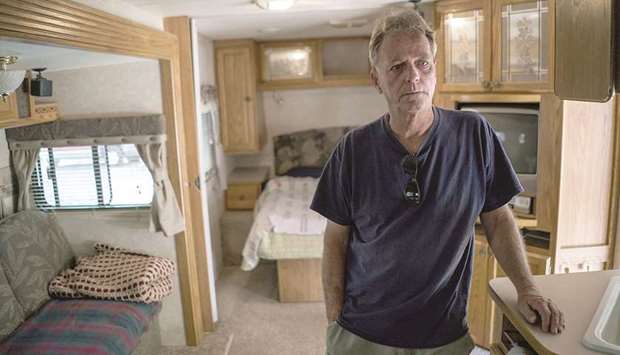But when he finally closed his eyes, Taylor could not escape the flashbacks: the screams of his neighbours, the scorched rubble where his house once stood. So he stumbled back outside and agonised in the darkness.
“If I’d known the fire would move that fast, I would have grabbed my stepfather’s Italian guns, the wedding rings, the photos of Raymond Jr. as a kid. The stuff you can never have again.”
With California entering peak wildfire season, it is a blaze from more than a year ago that still torments many who live in the rugged, picturesque enclaves of the Southern Sierra Nevada.
Nearly 300 families lost homes in the Erskine fire, the most destructive wildfire in Kern County history. The blaze, which erupted on June 23, 2016, consumed more than 48,000 acres in steep terrain near Lake Isabella and killed two people before it was subdued.
The fire gutted the hillside hamlet of South Lake, a community of low-income residents and retirees, leaving people like Taylor homeless for months and transforming the once-lively neighbourhood into a charred ghost town.
Two hundred families were insured for fire damage, but even they were not guaranteed immediate housing. Some chose to rebuild; others moved away.
Dozens of victims stayed in campgrounds across the Kern River Valley. A handful remain without permanent homes. Today, the streets of South Lake are quiet, most of the burned lots still vacant.
Taylor and his wife, Linda, lived for nearly 13 months in a travel trailer.
At first, they stayed in motels. But money ran short, and the couple, both retired, needed something more stable.
They learned that insurance would pay for the used 28-by-8-foot trailer, and Rivernook Campground just north of Lake Isabella would let them stay for free. They moved into the campground four weeks after the blaze.
Taylor, 63, was so grateful to have a place to live that he cried. He also was grateful for donated clothes and water and money, though he felt too embarrassed to take much.
The pain of losing everything was numbing. A few days after evacuating, he returned to South Lake, sneaking through dirt roads the highway patrol hadn’t closed off.
His house was gone. So was the garden, where he grew the “perfect tomatoes.” His redwood fence. The patio. The pond, the waterfall.
He had spent 20 years building his life there, planting a garden and designing a patio where he could sit and gaze at the hills hemming in Lake Isabella. It was a beautiful yard, crafted with the scrupulous touch of a career landscaper.
When the fire erupted on that hot June day, he tried to save his house with a high-pressure garden hose. He couldn’t just leave it.
The fire had swept down the road, shooting up trees and engulfing homes. Propane tanks exploded with the ferocity of cannon shots. A firefighter yelled from smoky obscurity – “Get out!” – and Taylor reluctantly began to run, eyes burning, his hose a feeble defence against the wall of flames swallowing the sagebrush next door.
In the weeks that followed, he and his sister, who drove up from Palm Springs, sifted through the rubble of the former master bedroom, searching for the lost wedding rings. Those were gone too.
Taylor and Linda were unsure what to do. Should they rebuild? Should they move? Taylor would not leave the valley – his ageing mother needed his care.
Instead of making a decision, they stayed put in the campground. Life was a daze. Taylor visited his mother and stepfather, who suffers from Alzheimer’s disease, or sat in the foldout chair in front of the trailer, drinking to dull the nagging guilt. Linda watched hours of MASH reruns inside.
Taylor lost 17 pounds and his health worsened.
He could not watch Fourth of July fireworks light up the sky over Lake Isabella. He could not barbecue. The smell of campfires was nauseating.
Last August, Taylor was sitting in the foldout chair when he saw firefighters zoom down the road outside the campground. Smoke from the 29,000-acre Cedar fire in Sequoia National Forest snaked into the valley, its residents still raw from the Erskine blaze less than two months earlier.
“What? Put it out!” Taylor yelled from his perch to no one.
And to the fire, he said, “Leave me alone.”
Sharing close quarters strained the couple’s marriage. The trailer, too, was strained from the Taylors’ extended stay. The top leaked after rain, and the awning nearly caved in after heavy snow in the winter. They were too afraid to use the oven.
His reprieve came in the fall. When the rain came, so did the ducks.
Taylor bought 50-pound bags of feed for them and offered peanuts to the squirrels that scurried by.
Sometimes his favourite, named Betty, sat on his shoulder while he talked to her, a trusted companion during those long days.
“That kept me,” Taylor said. “There is life.”
After a few months, when he sat in his chair outside the trailer, Taylor pleaded with himself to stop second-guessing his decisions on the day of the fire. He couldn’t have saved anything.
Slowly, officials removed toxic materials from what was left of the South Lake properties. By the end of the fall, the lots were safe for occupancy.
In December, after months of indecision and hours of phones calls, Taylor planned their next move. They would rebuild on their empty lot.
The county was limited in how much it could help victims.
Most individual efforts at recovery fall within the private sector, said Georgianna Armstrong, Kern County’s emergency services manager. Government officials can step in to offer housing assistance in rare cases that are declared federal emergencies, but President Obama did not elevate the Erskine fire to that status.
The nonprofit Kern Valley Long Term Recovery Group helped connect fire victims to case managers, said director Justin Powers, but the group had little money to help them rebuild.
Many families, especially those with limited means, were left in a state of paralysis, unsure how to find stable housing.
“Disaster incidents disproportionately affect people with income limitations,” Armstrong said. “And many times a lot of those people just kind of fade away. They make their life work, but it’s outside the scope of what government or emergency services would do. They make their way.”
A year after the Erskine fire, people are slowly trickling back to South Lake. Dirt and rocks clutter dozens of empty lots. Trees are scorched, mailboxes bent. The hills above the neighbourhood are scarred an ashy black.
In May, 27 eligible low-income families moved into temporary units donated by the federal government’s emergency management agency. A low buzz of construction work punctuates the streets, as some families rebuild homes as the Taylors did.
Though residents can rebuild, they still must live with the emotional wreckage wrought by the Erskine fire.
They tense up when smoke from a wildfire drifts into the valley. Everett Evans, a former firefighter, runs through a mental checklist: Where’s the fire, how fast is it moving, where’s it headed next?
Melanie Perea’s son Nathan, 7, who lives with her ex-boyfriend’s mother, draws pictures of his family running away from the fire. The boy is fearful of another blaze and tells his mother he no longer wants to live in the Kern River Valley.
Perea, 37, moved into a bright white federal assistance unit after living in a trailer on her property for months. It’s small, and the midafternoon wind squeezes into the kitchen through vents and cracks in the door, rattling the walls.
She used to earn money cleaning her neighbours’ houses each week, but those houses are now gone.
Perea doesn’t like to look out of the window at the empty lots and burnt trees.
“Everybody was here, everybody knew everybody. And now there’s nothing,” she said.
After half a year of construction, Taylor and Linda earlier this month moved into a manufactured home on their old property. Except for a neighbour on the corner, the street is deserted.
The yard is barren, and the interior of the house is sparsely decorated with items provided by a local church.
Though it’s not home yet, Linda smiled at the thought of cooking again after a year of microwaved meals.
“This is like a castle to me,” she said.
Taylor, on the other hand, doesn’t yet feel comfortable in the house. He’ll never be able to re-create his garden exactly as it was before.
Still, he finds hope in the signs of life returning to the neighbourhood. Pink and white oleanders now blossom on some street corners. Taylor thought the plants had been burned to a crisp.
“They came back,” he marvelled. -TNS



